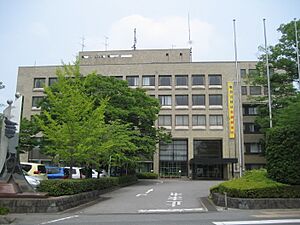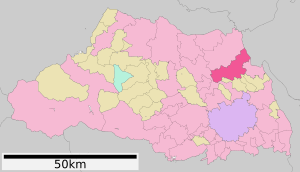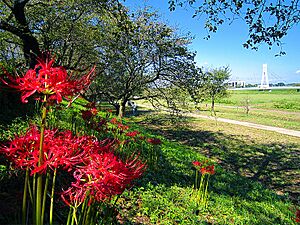Kuki, Saitama facts for kids
Quick facts for kids
Kuki
久喜市
|
|||||||||||
|---|---|---|---|---|---|---|---|---|---|---|---|

Kuki City Hall
|
|||||||||||
|
|||||||||||

Location of Kuki in Saitama Prefecture
|
|||||||||||
| Country | Japan | ||||||||||
| Region | Kantō | ||||||||||
| Prefecture | Saitama | ||||||||||
| Town Settled | April 1, 1889 | ||||||||||
| City Settled | October 1, 1971 | ||||||||||
| Area | |||||||||||
| • Total | 82.41 km2 (31.82 sq mi) | ||||||||||
| Population
(December 2010)
|
|||||||||||
| • Total | 152,569 | ||||||||||
| • Density | 1,851.34/km2 (4,794.95/sq mi) | ||||||||||
| Time zone | UTC+9 (Japan Standard Time) | ||||||||||
| Phone number | 0480-22-1111 | ||||||||||
| Address | 85-3 Shimohayami, Kuki-shi, Saitama-ken 346-8501 | ||||||||||
| Climate | Cfa | ||||||||||
|
|||||||||||
Kuki (written as 久喜市 in Japanese) is a city in Saitama Prefecture, Japan. As of December 2020, about 152,569 people lived there in 67,339 homes. The city covers an area of about 82.41 square kilometers (31.82 square miles).
Contents
Geography and Location
Kuki is in the northeastern part of Saitama Prefecture. It is about 50 kilometers (31 miles) away from central Tokyo. The city is located on the flat plains near the Tone River.
Neighboring Cities and Towns
Kuki is surrounded by several other cities and towns.
* Goka * Koga
* Hasuda * Kazo * Kōnosu * Miyashiro * Okegawa * Satte * Shiraoka * Sugito
Climate of Kuki
Kuki has a humid subtropical climate. This means it has warm summers and cool winters. There is usually little to no snowfall.
The average temperature in Kuki is about 14.6°C (58.3°F). The city gets about 1338 mm (52.7 inches) of rain each year. September is usually the wettest month.
- The warmest month is August, with an average temperature of about 26.7°C (80.1°F).
- The coldest month is January, with an average temperature of about 3.6°C (38.5°F).
| Climate data for Kuki (1991−2020 normals, extremes 1977−present) | |||||||||||||
|---|---|---|---|---|---|---|---|---|---|---|---|---|---|
| Month | Jan | Feb | Mar | Apr | May | Jun | Jul | Aug | Sep | Oct | Nov | Dec | Year |
| Record high °C (°F) | 18.3 (64.9) |
24.2 (75.6) |
26.2 (79.2) |
30.7 (87.3) |
34.4 (93.9) |
36.1 (97.0) |
38.6 (101.5) |
38.9 (102.0) |
37.7 (99.9) |
32.7 (90.9) |
25.6 (78.1) |
25.0 (77.0) |
38.9 (102.0) |
| Mean daily maximum °C (°F) | 9.4 (48.9) |
10.4 (50.7) |
13.9 (57.0) |
19.5 (67.1) |
23.9 (75.0) |
26.5 (79.7) |
30.4 (86.7) |
31.8 (89.2) |
27.6 (81.7) |
21.9 (71.4) |
16.5 (61.7) |
11.6 (52.9) |
20.3 (68.5) |
| Daily mean °C (°F) | 3.6 (38.5) |
4.6 (40.3) |
8.1 (46.6) |
13.4 (56.1) |
18.4 (65.1) |
21.8 (71.2) |
25.5 (77.9) |
26.7 (80.1) |
22.9 (73.2) |
17.2 (63.0) |
11.1 (52.0) |
5.8 (42.4) |
14.9 (58.9) |
| Mean daily minimum °C (°F) | −1.6 (29.1) |
−0.7 (30.7) |
2.6 (36.7) |
7.7 (45.9) |
13.6 (56.5) |
18.0 (64.4) |
21.9 (71.4) |
22.9 (73.2) |
19.2 (66.6) |
13.0 (55.4) |
6.1 (43.0) |
0.6 (33.1) |
10.3 (50.5) |
| Record low °C (°F) | −9.4 (15.1) |
−10.6 (12.9) |
−4.6 (23.7) |
−2.0 (28.4) |
3.7 (38.7) |
10.6 (51.1) |
14.1 (57.4) |
14.9 (58.8) |
9.0 (48.2) |
3.2 (37.8) |
−2.9 (26.8) |
−6.7 (19.9) |
−10.6 (12.9) |
| Average precipitation mm (inches) | 43.2 (1.70) |
38.6 (1.52) |
82.0 (3.23) |
99.5 (3.92) |
124.2 (4.89) |
142.7 (5.62) |
147.3 (5.80) |
146.8 (5.78) |
199.2 (7.84) |
190.9 (7.52) |
65.4 (2.57) |
41.6 (1.64) |
1,321.4 (52.02) |
| Average precipitation days (≥ 1.0 mm) | 3.9 | 4.8 | 8.5 | 9.2 | 10.3 | 11.6 | 11.6 | 8.4 | 11.3 | 10.1 | 6.3 | 4.3 | 100.3 |
| Mean monthly sunshine hours | 204.3 | 191.0 | 191.5 | 188.7 | 187.6 | 132.4 | 150.8 | 178.6 | 136.3 | 140.9 | 162.1 | 186.0 | 2,050.2 |
| Source: JMA | |||||||||||||
Population Changes Over Time
The number of people living in Kuki grew for a long time. Recently, the population has stayed about the same.
| Historical population | ||
|---|---|---|
| Year | Pop. | ±% |
| 1950 | 59,114 | — |
| 1960 | 60,409 | +2.2% |
| 1970 | 74,477 | +23.3% |
| 1980 | 114,920 | +54.3% |
| 1990 | 141,400 | +23.0% |
| 2000 | 154,292 | +9.1% |
| 2010 | 154,310 | +0.0% |
| 2020 | 150,582 | −2.4% |
History of Kuki
Kuki has a long history.
- During the Sengoku period (a time of wars in Japan), a leader named Ashikaga Masauji lived in a temple in what is now Kuki.
- Later, during the Edo period, a small area called Kuki Domain existed from 1684 to 1798.
- The modern town of Kuki was officially created on April 1, 1889.
- On July 1, 1954, Kuki joined with some nearby villages.
- Kuki became a city on October 1, 1971.
- On March 23, 2010, Kuki grew bigger by joining with the towns of Shōbu, Kurihashi, and Washimiya.
Economy and Industry
Kuki is mostly a farming area. Rice is the main crop grown here. The city also has three industrial parks where different businesses operate.
Education in Kuki
Kuki has many schools for students of all ages.
- Tokyo University of Science has a campus in Kuki.
- The city government runs 23 public elementary schools and 11 public middle schools.
- The Saitama Prefecture runs five public high schools.
- There is also one special education school for students with disabilities.
Transportation in Kuki
It is easy to travel to and from Kuki by train and car.
Railway Lines
 JR East – Utsunomiya Line (which is part of the Tōhoku Main Line)
JR East – Utsunomiya Line (which is part of the Tōhoku Main Line)
* Kuki * Higashi-Washinomiya * Kurihashi
* Kuki * Washinomiya
* Kurihashi * Minami-Kurihashi
Highways
 Ken-Ō Expressway – Shobu Parking Area – Kuki-Shiraoka Junction
Ken-Ō Expressway – Shobu Parking Area – Kuki-Shiraoka Junction Tōhoku Expressway – Kuki-Shiraoka Junction – Kuki Interchange
Tōhoku Expressway – Kuki-Shiraoka Junction – Kuki Interchange National Route 4
National Route 4 National Route 122
National Route 122 National Route 125
National Route 125
Fun Places to Visit
Kuki is known as the setting for some popular Japanese anime series. These include Lucky Star and The Fruit of Grisaia. Because of this, many anime fans visit Washinomiya Shrine each year.
Sister City
Kuki has a sister city in the United States:
 Roseburg, Oregon, United States
Roseburg, Oregon, United States
See also
 In Spanish: Kuki (Saitama) para niños
In Spanish: Kuki (Saitama) para niños





